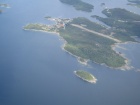|
This was the first day in southern Chile
that we hit bad weather. It was also the first (and only) time on our
trip that we had to change our destination because of weather. But we
had been told to expect this in this region due to the westerly winds
that brought a lot of humidity with them. The other side of the Andes in
Argentina is sheltered from the worst of the weather and that is the
route most VFR pilots take. But, while in Chile, we wanted to stay in
Chile and fly low through the beautiful Patagonian fjords to a landing
strip at the glacier of Laguna San Rafael, apparently the region’s most
impressive attraction. It had been raining hard all night, but the IR
satellite map and tafs of Balmaceda, Puerto Natales and Punta Arenas
looked pretty good. Termas Puyahuapi does not normally provide internet
access for guests, but the hotel management was kind enough to let us
use their computer.
We were doing fine at 3500 feet or so until just 10 nautical miles north
of Laguna San Rafael, where we got stopped by heavy rain. A local pilot
from Puerto Aysen who departed Puyuhuapi for Laguna San Rafael 10
minutes after us with 6 British tourists had to abandon the idea of
landing in Laguna San Rafael as well.
We had to keep clear of the clouds to avoid icing, so backtracked a bit
to find a break in them to climb on top at FL135 (13,500 ft above sea
level). We were too far from Puerto Montt to contact Operations by VHF
radio so used the satellite phone to change our destination to Villa
O´Higgins, the southernmost village that can be reached by road on the
Carretera Austral.
Well, that did not work either as hardly any VFR holes were found in the
solid cloud cover, so we changed destination again to Puerto Natales
(with an IFR approach into Punta Arenas as back-up). To keep on top of
the clouds and icing, we had to go up to FL155 and later FL175. The
plane won’t go much higher than that! It was good that we had plenty of
oxygen on board. Winds were 290 degrees at 80 knots, so a 30 degree crab
was needed to stay on track south.
Angela was praying that there would be some holes in the clouds to allow
us to make the visual approach to Puerto Natales. For one thing, she was
anxious to get on the ground, and, for another, it would be a long drive
from Punta Arenas to the big attraction Parque Nacional Torres del Paine
where she had managed with great difficulty to book accommodation before
we’d even left Geneva. Well, her prayers were answered! Puerto Natales
was bathed in pristine clear sunlight as we made the approach. On the
other hand, it was too turbulent to doing any filming. Winds were 300
degrees at 33 knots when landing on runway 28, and a heavy rain shower
arrived just after us.
This was the second worrying flight of the trip – the first being the
south Atlantic crossing – so I suppose that’s not bad going! |

Heading from Puyuhuapi to Laguna San Rafael
|

Puerto Aguirre island with its airstrip near Puerto Aysen. Shortly before the weather deteriorated.
|



